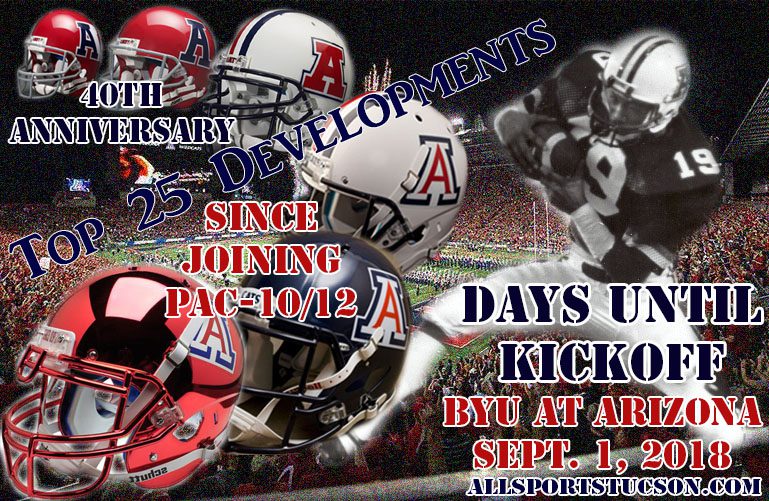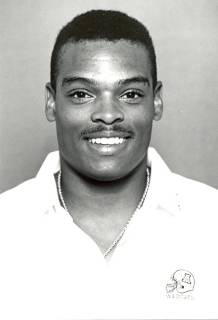We have reached 19 days until the Arizona Wildcats kick off their 2018 campaign under new coach Kevin Sumlin. The season begins when Arizona hosts BYU on Sept. 1 at Arizona Stadium.
To get ready for the upcoming season, All Sports Tucson offers another countdown, which includes memories from former Wildcats, history notes and a look ahead to the season. Think of it as a way to keep Arizona football on the mind in the summer months leading up to fall camp in early August and then kickoff against the Cougars marking the start of the Sumlin Era.

The season marks some substantial anniversaries. It is the 40th anniversary since the Wildcats left the WAC to join the Pac-12 (went from the Pac-8 to the Pac-10 then) and also the 20th anniversary of the 1998 team with the best record in school history, 12-1, and the 25th anniversary of the 1993 team that went 10-2 with a win over Miami in the Fiesta Bowl.
To catch up on the countdown — which included in-depth analysis and reader polls on The Great Debate of which team was better — 1993 or 1998 — click on this: Arizona Wildcats 2018 countdown to kickoff.
Top 25 developments in Pac-10/12 era
Over the last part of the countdown we are ranking the top 25 developments of Arizona’s Pac-10/12 existence that started in 1978 when it arrived with ASU from the WAC. The ranking will include player highlights, team accomplishments, coaching moves and other off-field developments. If a player is involved, the ranking includes happenings only during the course of that athlete’s time at Arizona.
The ranking up to now:
No. 25: Darryll Lewis’ 1990 season
No. 24: Chris McAlister’s career
No. 21: Scooby Wright III’s 2014 season
No. 20: Rich Rodriguez’s tenure
No. 19
Win over No. 1 Washington in 1992
The definitive voice of college football broadcasts — Keith Jackson — punctuated the ABC-TV telecast of Arizona’s dominating 1992 win over No. 1 Washington this way:
“And now you know why they play the games …”
But was the one-sided victory really an upset?
“I don’t think it was an upset,” Arizona coach Dick Tomey said after the game. “We expected to win.”

Arizona Daily Star clipping of Arizona’s upset of No. 1 Washington in 1992.
Another translation to Jackson’s comment: Washington had to play Arizona to realize how suffocating the Desert Swarm defense — a phenomenon in college football at the time — can be to an opponent’s offense. Considering Arizona’s four-game winning streak entering the game after a near-upset of No. 1 Miami on the road, and the way the Wildcats shut down the Huskies, was anybody surprised Arizona won?

From the Field — Tony Bouie, former Arizona safety and member of the Desert Swarm defense
“I remember that Billy Joe Hobert situation we felt was going to be a distraction for them. Our identity as the Desert Swarm was still young but we still have a lot of confidence going into a game. The first play of the game on defense by Rob Waldrop really set the tone. In the huddle, we all had an intensity that everyone really understood. We carried that throughout the game to a victory with the number one team in the country.”
Washington was ranked No. 1 with an incredible 22-game winning streak, but anybody who followed college football closely that season knew Arizona belonged on the same field. The Desert Swarm was No. 1 in the nation against the run and No. 4 overall.
“I’ve never been more confident going into a game,” Tomey said.
This statement coming from a coach whose team less than two months earlier tied an Oregon State club that finished 1-9-1. Washington beat its first eight opponents in 1992 by an average margin of 20.1 points. The Huskies annihilated the Wildcats 54-0 the previous season in Seattle. Still, the Wildcats believed they were the better team and who could argue?
“I had just been voted team captain that week,” Arizona’s Heath Bray, a backup quarterback, defensive back and linebacker that season, told Tucson sports journalist Anthony Gimino in a 2010 interview.
“When the refs came into the locker room before the game to call for captains for the coin toss, it was like balloons fell from the ceiling. Everything was in the air — helmets, pads, cups. Everybody was screaming and yelling. It was like a party. You wouldn’t have expected that. We walked out of the locker room that day, and there was not an empty seat in the house. You could tell from the coin flop, we were just going to win that game.”

Arizona beat the Huskies in 1992 in the same manner a boxer does not leave himself open and uses the bob and weave, a defensive maneuver to avoid a punch. The Wildcats played conservatively on offense — using the run in 54 out of 66 offensive plays — and decisively won the ball-control and field-position battle behind their defense and the punting of Josh Miller.
Miller, an All-Pac-10 selection, pinned the Huskies back continuously with his 47.3-yard average over eight punts. Washington never started a drive beyond its own 31-yard line.
Arizona quarterback George Malauulu completed only five of 12 passes for 54 yards but he did not fumble or throw an interception. In Washington’s 54-0 rout in 1991, Malauulu was responsible for six turnovers. That was Arizona’s worst loss in 32 years. The Wildcats, who ran effectively against the Huskies in 1992, were methodical and error-free.
Billy Johnson ran for 99 yards and Chuck Levy added 37 as Arizona gained 197 yards on the ground.
“I know our offense don’t look too good on the outside,” UA linebacker Sean Harris told the Los Angeles Times. “They didn’t do nothing in the first quarter. They didn’t do nothing in the second quarter. They didn’t do nothing in the third quarter. But they turned it on in the fourth quarter.”
The kicking of Arizona’s Steve McLaughlin, who missed a 51-yarder as time expired that would have beaten Miami, put the Wildcats in position to win with three field goals. He made a 34-yard field goal in the first half, the only scoring by halftime.

Arizona Keshon Johnson (8) is congratulated by Brandon Sanders and Darryl Morrison after an interception caused by a hit from Tony Bouie on a Washington receiver (YouTube video capture)
His 20-yard field goal with 12:38 remaining put the Wildcats ahead 6-3 and it culminated a 17-play, 74-yard drive that started in the third quarter. The Wildcats ground out 4.4 yards a play in that series, starting from its 23 and ending at the Washington 3-yard line.
“It’s not very fancy, but I do think teams underestimate it,” Levy was quoted by The Los Angeles Times about the UA’s offense. “It may be ugly, but we get the job done. Now they’re sitting in their locker room (wondering) how we won.”
Washington quarterback Mark Brunell fumbled on the next possession and Arizona’s Jim Hoffman recovered at the Huskies’ 20. Four plays later, McLaughlin made a 30-yard field goal to put the Wildcats ahead 9-3.
Arizona stopped Washington’s next drive when cornerback Keshon Johnson intercepted a Brunell pass with 8:37 left. Washington’s Jason Shelley made the reception, but was immediately hit by safety Tony Bouie, dislodging the ball into the air and into Johnson’s hands. Johnson returned the interception 21 yards to the UA 40 and Washington never threatened again.
A series later, after the Huskies’ punted from their 13, the Wildcats drove from their 43 and scored the game’s only touchdown on Malauulu’s 1-yard keeper with 48 seconds remaining. The only drama remaining at that time was Arizona’s crowd trying to rush the field before the game came to an end.

Arizona punter Josh Miller was chosen the ABC-TV player of the game for his performance against Washington (YouTube video capture)
“We won the turnover battle, the fourth quarter, the kicking game, and we dominated the line of scrimmage in the fourth quarter,” said Tomey afterward. “This was our day. It was time.”
Washington’s best scoring opportunity occurred late in the first half. The Huskies drove 72 yards to the Arizona 8 with a minute left before halftime. A bad snap on a 25-yard field-goal attempt forced holder Eric Bjornson to try a pass to tight end Mark Bruener in the end zone. Bruener, who was open, dropped the football. Arizona’s streak of not allowing a first-half touchdown that season remained intact.
Washington fumbled four times, losing three. Brunell, who did not share the quarterback responsibilities with Billy Joe Hobert (out while being investigated by Washington for receiving an alleged improper loan), threw an interception and looked rattled by the constant pressure from Rob Waldrop, Jimmie Hopkins and Tedy Bruschi.
Brunell completed 25 of 41 passes for a career-high 243 yards but he could never sustain a long drive for the Huskies. Washington’s star running back Napoleon Kaufman rushed for only 50 yards and fumbled twice.
“I’m not going to get into anything about the Billy Joe Hobert case,” Brunell told reporters. “It had no impact, and I’m not going to talk about it.”

The scoreboard shows the final score of Arizona’s upset win over No. 1 Washington with the fans celebrating on the field (YouTube video capture)
“It didn’t really matter to us,” Waldrop, Arizona’s All-American nose tackle, said after the game. “Whatever they bring in, we’ll stop it. It didn’t matter if it were Hobert, Brunell or if the third-string guy was in there.”
Arizona’s victory put itself in position to earn its first Rose Bowl appearance with a 4-1-1 Pac-10 record. The Wildcats needed two more conference victories — against Southern Cal and Arizona State — coupled with a tie or loss by Washington (5-1 in conference) and they would be bound for Pasadena.
But the Wildcats stumbled with a 14-7 loss at USC before losing to ASU 7-6 at Arizona Stadium. They ended the year with a 20-15 humbling loss to Baylor in the Sun Bowl. Washington lost two of its last three games, including the Rose Bowl to Michigan 38-31.
The way the 1992 season ended does not take away from that special November afternoon in Tucson in front of an over-capacity crowd, the most electrifying and significant win at Arizona Stadium.
“We didn’t luckily win that ball game,” Bray told Gimino in 2010. “Let’s be very blunt about this: We beat their ass.”
The best to wear No. 19 …
The best to wear No. 19 for the Arizona Wildcats is cornerback Allan Durden, who played for the Wildcats from 1982 to 1985 and started the run of Arizona’s all-conference defensive backs from San Diego’s Helix High School, followed by Chuck Cecil and Jeff Hammerschmidt. Durden was a first-team All-American in 1985 as chosen by UPI, Walter Camp and Football News.

Allan Durden was a first-team All-American in 1985 as chosen by UPI, Walter Camp and Football News (University of Arizona photo)
Wearing No. 19 now …
Two players are wearing the number now, and they are standouts — fifth-year senior receiver Shawn Poindexter and sophomore safety Scottie Young Jr..
Poindexter, a 6-5, 218-pound target, emerged with a solid
Embed from Getty Imagesseason last year with 19 catches for 294 yards in an offense predicated by the run, mostly by the quarterbacks.
Young played extensively as a true freshman, making nine starts at free safety. He finished the season sixth on team with 53 tackles despite missing three games. He totaled 3.5 tackles for loss, intercepted one pass and broke up another. He will not play against BYU because he is serving a one-game suspension because of an arrest in connection to a domestic violence incident in which he was charged with assault/knowingly causing injury, a misdemeanor.
While the football program has never tied that incident to it, Young was suspended from all football-related activities for the whole of spring and on into the summer this offseason. Late this past week, the university announced in a press release that, while the defensive back will be permitted to rejoin his teammates on the practice field this week, he will be suspended for the opener against the Cougars.
FOLLOW @JAVIERJMORALES ON TWITTER!
ALLSPORTSTUCSON.com publisher, writer and editor Javier Morales is a former Arizona Press Club award winner. He is a former Arizona Daily Star beat reporter for the Arizona basketball team, including when the Wildcats won the 1996-97 NCAA title. He has also written articles for CollegeAD.com, Bleacher Report, Lindy’s Sports, TucsonCitizen.com, The Arizona Republic, Sporting News and Baseball America, among many other publications. He has also authored the book “The Highest Form of Living”, which is available at Amazon.


















